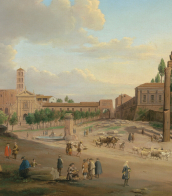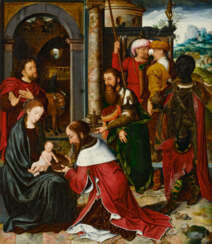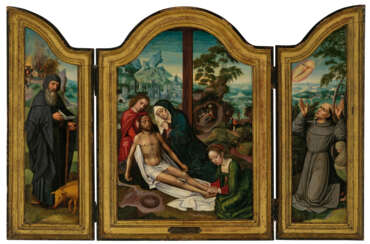550

Hans Sebald Beham was a German painter and printmaker, mainly known for his very small engravings.


Ambrosius Benson was an Italian painter who became a part of the Northern Renaissance.
While many surviving paintings have been attributed, there is very little known of him from records, and he tended not to sign his work. He is believed to be responsible for mainly religious art, but also painted portraits on commission. He sometime painted from classical sources, often setting the figures in modern-dress, or a contemporary domestic setting. In his lifetime he was successful; he had a large workshop, his work was sold internationally and he was especially popular in Spain.


Hans Sebald Beham was a German painter and printmaker, mainly known for his very small engravings.


Hans Sebald Beham was a German painter and printmaker, mainly known for his very small engravings.


Hans Sebald Beham was a German painter and printmaker, mainly known for his very small engravings.


Hans Sebald Beham was a German painter and printmaker, mainly known for his very small engravings.


Hans Sebald Beham was a German painter and printmaker, mainly known for his very small engravings.


Hans Sebald Beham was a German painter and printmaker, mainly known for his very small engravings.


Hans Sebald Beham was a German painter and printmaker, mainly known for his very small engravings.


Giuseppe Niccolò Vicentino, called Rospigliosi, was an Italian painter and wood-engraver of the Renaissance. His method was chiaroscuro. He used three blocks, and did much to develop the process. Among other cuts by him are: A Sibyl reading a Book; Hercules killing the Nemaean Lion after Raphael; Death of Ajax after Polidoro da Caravaggio; Venue embracing Cupid; and Glelia escaping from Porsenna's camp.


Ambrosius Benson was an Italian painter who became a part of the Northern Renaissance.
While many surviving paintings have been attributed, there is very little known of him from records, and he tended not to sign his work. He is believed to be responsible for mainly religious art, but also painted portraits on commission. He sometime painted from classical sources, often setting the figures in modern-dress, or a contemporary domestic setting. In his lifetime he was successful; he had a large workshop, his work was sold internationally and he was especially popular in Spain.


Hans Sebald Beham was a German painter and printmaker, mainly known for his very small engravings.


Ambrosius Benson was an Italian painter who became a part of the Northern Renaissance.
While many surviving paintings have been attributed, there is very little known of him from records, and he tended not to sign his work. He is believed to be responsible for mainly religious art, but also painted portraits on commission. He sometime painted from classical sources, often setting the figures in modern-dress, or a contemporary domestic setting. In his lifetime he was successful; he had a large workshop, his work was sold internationally and he was especially popular in Spain.


Hans Sebald Beham was a German painter and printmaker, mainly known for his very small engravings.


Hans Sebald Beham was a German painter and printmaker, mainly known for his very small engravings.


Hans Sebald Beham was a German painter and printmaker, mainly known for his very small engravings.


Ambrosius Benson was an Italian painter who became a part of the Northern Renaissance.
While many surviving paintings have been attributed, there is very little known of him from records, and he tended not to sign his work. He is believed to be responsible for mainly religious art, but also painted portraits on commission. He sometime painted from classical sources, often setting the figures in modern-dress, or a contemporary domestic setting. In his lifetime he was successful; he had a large workshop, his work was sold internationally and he was especially popular in Spain.


Ambrosius Benson was an Italian painter who became a part of the Northern Renaissance.
While many surviving paintings have been attributed, there is very little known of him from records, and he tended not to sign his work. He is believed to be responsible for mainly religious art, but also painted portraits on commission. He sometime painted from classical sources, often setting the figures in modern-dress, or a contemporary domestic setting. In his lifetime he was successful; he had a large workshop, his work was sold internationally and he was especially popular in Spain.


Ambrosius Benson was an Italian painter who became a part of the Northern Renaissance.
While many surviving paintings have been attributed, there is very little known of him from records, and he tended not to sign his work. He is believed to be responsible for mainly religious art, but also painted portraits on commission. He sometime painted from classical sources, often setting the figures in modern-dress, or a contemporary domestic setting. In his lifetime he was successful; he had a large workshop, his work was sold internationally and he was especially popular in Spain.


Raffaello Santi was an Italian artist, famously known for his contributions to the world of culture and art. Born in Urbino, Italy, in 1483, Raffaello Santi, commonly known as Raphael, was a renowned painter and architect during the Italian Renaissance. His exceptional talents in the realms of painting and sculpture have left an indelible mark on the art world, earning him a place among the greatest artists of all time.
Raphael's works are celebrated for their exquisite detail, harmonious compositions, and the graceful beauty of his subjects. He is best known for his remarkable frescoes in the Vatican Palace, including the famous "School of Athens," which exemplifies his mastery in blending classical antiquity with contemporary artistic sensibilities. His ability to capture the human form with unparalleled accuracy and sensitivity has earned him a reputation as a true virtuoso.
Among his other notable works are "The Sistine Madonna" and "The Transfiguration," both of which showcase his exceptional skills in portraying religious subjects with a captivating emotional depth. These paintings, along with many others, are now cherished treasures in museums and galleries worldwide, drawing art enthusiasts and experts alike to admire Raphael's timeless creations.
For collectors and art connoisseurs, Raphael's works are highly sought after, not only for their historical significance but also for their aesthetic appeal. His pieces continue to command great value in the art market, making them a valuable addition to any art collection.
If you are passionate about culture, art, and the works of this celebrated artist, consider signing up for updates related to Raphael Santi. Stay informed about new product sales and auction events featuring his masterpieces, and have the opportunity to acquire a piece of art history for yourself. Don't miss the chance to immerse yourself in the world of Raphael and his timeless contributions to the realm of art. Subscribe today and be a part of preserving his legacy.

Giuseppe Niccolò Vicentino, called Rospigliosi, was an Italian painter and wood-engraver of the Renaissance. His method was chiaroscuro. He used three blocks, and did much to develop the process. Among other cuts by him are: A Sibyl reading a Book; Hercules killing the Nemaean Lion after Raphael; Death of Ajax after Polidoro da Caravaggio; Venue embracing Cupid; and Glelia escaping from Porsenna's camp.


Hans Sebald Beham was a German painter and printmaker, mainly known for his very small engravings.


Hans Sebald Beham was a German painter and printmaker, mainly known for his very small engravings.


Marin le Bourgeoys was a distinguished French artist and inventor, renowned for his creation of the flintlock mechanism that revolutionized firearms for over two centuries. Born into an esteemed artisan family in Lisieux, Normandy, le Bourgeoys was initially trained as a painter, later gaining acclaim as a gunsmith, inventor, and luthier.
His talents soon caught the eye of royalty; in 1598, King Henry IV appointed him "Valet de Chambre" at the Royal Court, a testament to his esteemed position in the realms of art and innovation. Le Bourgeoys' ingenuity extended beyond the court; his flintlock mechanism, invented in the early seventeenth century, was a pivotal development in firearm technology. This mechanism featured a striking device that, when the trigger was pulled, would hit a firing pin to ignite the primer in the gun cartridge, a design so advanced that it remained in use for over two centuries.
As an artist, le Bourgeoys' work was not limited to the functional; he was also a creator of luxury items, a clock-maker, and embodied the spirit of an educated Renaissance humanist thriving in cultivated circles. His legacy in the art world is marked by works such as the portrait of Henri IV, which was recently acquired by the Musée de l'Armée, signifying the lasting appreciation of his artistic prowess.
For collectors, auctioneers, and experts in art and antiques, Marin le Bourgeoys' contributions to both art and firearm technology present a rich tapestry of historical and cultural significance. To stay informed on updates and discoveries related to Marin le Bourgeoys, sign up for our exclusive newsletter.


Giuseppe Franco, an Italian painter active between 1565 and 1628, remains an enigmatic figure in the rich tapestry of art history. Known by various names, including Giuseppe Franchi, Giuseppe Monti, and Giuseppe dalle Lodole, his diverse monikers reflect the multifaceted nature of his work and the period's artistic fluidity.
Rooted in the transition from the Renaissance to the Baroque, Franco's artistry is characterized by its dynamic compositions and emotional intensity. While specific details of his oeuvre are less documented, his known works suggest a mastery of form and color, embodying the evolving styles of his time. Franco's paintings, presumably found in Italian churches and private collections, would offer a glimpse into the religious and cultural narratives prevalent during his lifetime.
Franco's contributions to art and culture are significant for their historical context and the light they shed on the period's aesthetic developments. His style, indicative of the early Baroque's emerging vibrancy, would have played a role in the transition from the classical harmony of the Renaissance to the expressive drama of the Baroque.
For collectors and experts in art and antiques, Giuseppe Franco's works represent a fascinating puzzle piece of history, bridging gaps between known artistic milestones. His paintings, if extant, would be prized not only for their beauty but also for their historical value, offering insights into the era's shifting paradigms.
To explore the mystery and beauty of Giuseppe Franco's art and to stay informed about potential discoveries, sales, and auction events related to his work, signing up for updates is recommended. This subscription ensures direct access to the latest information, catering specifically to enthusiasts of historic art and antiques.


Ambrosius Benson was an Italian painter who became a part of the Northern Renaissance.
While many surviving paintings have been attributed, there is very little known of him from records, and he tended not to sign his work. He is believed to be responsible for mainly religious art, but also painted portraits on commission. He sometime painted from classical sources, often setting the figures in modern-dress, or a contemporary domestic setting. In his lifetime he was successful; he had a large workshop, his work was sold internationally and he was especially popular in Spain.


Giulio Romano, an Italian prodigy in painting and architecture, is celebrated for his dynamic contributions to the Renaissance and Mannerist styles. A pivotal figure in the late Renaissance, Giulio Romano was not only Raphael's principal pupil but also a trusted assistant, inheriting his master's workshop upon his death in 1520.
Giulio Romano's artistic journey began under Raphael's tutelage, where he honed his skills in both painting and architecture. His work vividly reflects the essence of the High Renaissance yet also signals the advent of Mannerism, a style characterized by elongated forms and exaggerated emotions. Notably, Romano's architectural prowess was largely self-taught, developed while assisting Raphael, who was the papal architect during that time.
The Palazzo del Te in Mantua stands as a testament to Giulio Romano's architectural genius. This pleasure palace, begun around 1524 and completed a decade later, showcases his inventive spirit and skill. It's a striking example of how Romano played with classical conventions to create something uniquely expressive. His ability to transform spaces was not just limited to grand structures but also extended to designing gardens and facades, enhancing their aesthetics and functionality.
In painting, Giulio Romano's works such as the Stoning of St. Stephen in Santo Stefano, Genoa, and the Adoration of the Magi in the Louvre, demonstrate his mastery and influence. His fresco "Fire in the Borgo" in the Raphael Rooms of the Vatican City is particularly noteworthy. Romano's drawings and designs, revered for their technical skill and creativity, significantly influenced subsequent artists, including Nicolas Poussin.
For art collectors and experts, the works of Giulio Romano present a fascinating blend of Renaissance classicism and the burgeoning Mannerist style. His contributions in both painting and architecture have left an indelible mark on the history of art and culture.
For those interested in staying updated on sales and auction events related to Giulio Romano, consider signing up for updates. This subscription is strictly for alerts on new product sales and auction events relevant to Romano's works. Avoid missing out on acquiring a piece of this Renaissance master's legacy.



Hans Sebald Beham was a German painter and printmaker, mainly known for his very small engravings.






























































